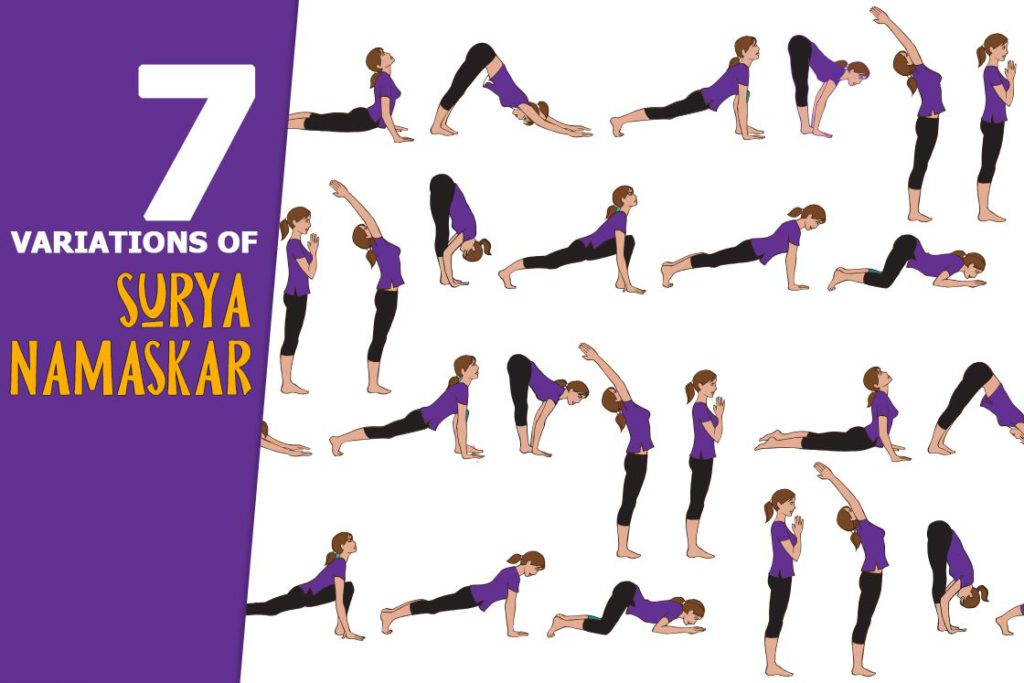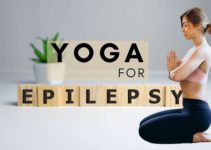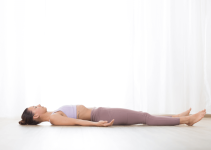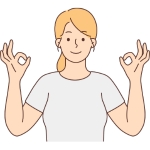- Half Sun Salutation
- Seated Sun Salutation
- Chair Sun Salutation
- Standing Chair Sun Salutation
- Quick Flow Sun Salutation
- Kneeling Sun Salutation
- Egyptian Sun Salutation

Surya Namaskar is a great strength-building sequence when performed correctly in a quick vinyasa. It moves the spine back and forth in repetition and tones the vertebrae. But sometimes it can be stressful to the spine, especially for beginners who aren’t accustomed to much spinal movement.
If your body isn’t suitable for a traditional type of sun salutation, you can modify its sequence of poses or break the sequence into an easy part.
Moreover, depending upon the need and particular condition of a student there can be added relaxing poses and some twisting movement in traditional sun salutation sequence. It makes several variations of Surya namaskar.
Some of the Surya Namaskar Variations are:
- Half Sun Salutation (Ardha Surya Namaskar)
- Seated Sun Salutation (Upavistha Surya Namaskar)
- Chair Sun Salutation (Sitting)
- Standing Sun Salutation in front of the chair
- Sun Salutation Quick Flow
- Kneeling Sun Salutation
- Egyptian Sun Salutation
Try these sun salutations variations below and choose the one you feel most comfortable in.
1. Half Sun Salutation (Ardha Surya Namaskar)
As the name suggests, the Half sun salutation is a part full Surya Namaskar sequence. Here specific poses (asanas) are performed at one place in front of the mat before you step back in any pose.
Half sun salutation has 7 poses in which one stretches up and forward without moving from a standing position. It’s best suitable to warm up the body in a home yoga session.
- Stand in tadasana (mountain pose) keeping the palm joined in front of the chest.
- Inhale raising the arms over the head and look up at the thumbs in Urdhva hastasana (raised arms pose).
- Exhale to fold forward in uttanasana (forward bend) pressing the hands to the floor aligning the fingertips with the toes.
- Inhale, lifting halfway up keeping the arms, legs, and back straight in Ardha uttanasana (half forward bend).
- Exhale to bend forward again bringing the head to the knees and pressing the palms against the floor in Uttanasana (forward bend).
- Inhale uplifting the torso and sweeping the arms upward in Urdhva hastasana (raised arms pose).
- Exhale lowering the arms and join the palms in prayer pose in front of the chest in tadasana (mountain pose)
2. Seated Sun Salutation (Upavistha Surya Namaskar)
Unlike traditional Surya Namaskar, this entire sequence is performed sitting on the floor (aka floor sun salutation). It involves stretching, forward folds, and heart-opener poses.
Seated Sun salutation is the best variation to try on for people who cannot access the standing one. Also, it’s best for beginners who are struggling in reaching the floor in the forward bends. It is quite easier than any other variation available for the aspirant practitioner.
- Sit in a crossed leg posture like padmasana or sukhasana.
- Inhale, raise the arms up overhead joining palm in seated upward salute. Bring your gaze to the palms.
- Exhale, lower the right arm to the sides and slide it away while tilting the trunk right side. Simultaneously, left arm reach up and over the head in seated upward salute right side.
- Inhale, bring both arms in centre over head.
- Exhale to lower the left arm and as the elbow lowers reach up with the right arm in seated upward salute left side.
- Inhale rejoin the palms over the head.
- Exhale to fold forward keeping the arms outstretched and surrender the head to ground like in child’s pose.
- Inhale drawing the arms halfway back and lift the chin for a slight back bend.
- Curl the spine backward at the heart level while exhaling.
- Inhale moving the hands behind you pointing the fingers forward.
- Now, lift your heart to the sky while leaning into your arms.
- Exhale to assume the starting position again and repeat a second round switching the crossing of the legs.
3. Chair Sun Salutation
Here chair is used as a supportive prop while performing Sun salutation. Elderly people, beginners with flexibility or mobility issues find it quite useful.
Chair sun salutation variation is suitable for any age group or body type. It’s also an alternative to seated sun salutation for people who face problems in sitting cross-legged posture. Although it provides massaging and stretching effects similar to the traditional one.
- Sit on a chair resting the feet on the floor and joining the palms in front of the chest.
- Exhale to join hands in the prayer pose in front of the chest.
- Inhale bringing your hands to the thighs and lengthen your neck and spine. Raise your arms overhead and look up gently.
- Exhale lowering your hands to the thighs and bend forward at the hips keeping the neck and spine erect. Now, slide your hands towards the feet keeping the neck relaxed.
- Inhale lifting yourself, grab your left thigh with both hands and draw it towards the abdomen. Keep your gaze fixed ahead.
- Exhale releasing your leg and bring your hands to the thighs. Lower your head and round your back to get into a seated Cat Pose.
- Inhale move your chest forward and look up assuming a seated Cow Pose.
- Again curl your back to get into the seated cat pose while exhaling.
- Inhale to come back to center and holding your left thigh lift it towards the abdomen as in step 5.
- Exhale releasing your leg back to the floor and hinge forward at the hips reaching your feet with the hands.
- Inhale raising the torso and sweeping the arms overhead and lookup.
- Exhale to return back to pose 1 joining the palms in front of the chest.
4. Standing Chair Sun Salutation
This variation shares similarity with the traditional Hatha Surya Namaskar using a chair as a prop. Here, the hands are placed on the chair’s back or seat to perform all the stretches.
In the standing chair sun salutation, the uttanasana is replaced by Ardha uttansana, and all the poses which are performed reaching the floor are modified reaching the chair. It’s a great way to buildup extension in the back muscles for the forward bends. So it’s recommended for beginners.
In this sequence, the strength and balance of the practitioner enhance and the body is prepared well for performing traditional Surya Namaskar.
- Stand behind a chair joining the palms in prayer pose pressed against the chest.
- Inhale raising the arms overhead and gently look up.
- Exhale lowering your hands on the back of the chair and fold halfway forward on your hips.
- Inhale stepping the left foot back as far as possible while holding the chair.
- Exhale bend the right knee and lock up.
- Inhale taking the right foot behind to place it beside the left.
- Exhale and bend slightly forward and while inhaling lift your heels off the floor.
- Pressing the arms on the chair stretch forward lifting the body on the toes.
- Exhale lowering the heels to the floor and again bend the torso halfway on the hips keeping the hands on the back of the chair.
- Inhale drawing the left foot forward and while exhaling bend the left knee and stretch the right leg straight backward.
- Inhale bringing the right leg forward placing beside the left.
- Exhale and hinge forward at the hips pressing the palms on the chair.
- Inhale lifting the torso and arms overhead stretching the neck to look up.
- Exhale lower the arms and join the palms in front of the chest.
5. Quick Flow Sun Salutation
It is a body warm-up variation of Surya Namaskar involving five poses, namely uttanasana, chaturanga dandasana, bhujangasana, down-dog, and getting back into uttansana.
This cyclic variation is performed using the core strength and the sequence involves only five asanas that are practiced without taking much time, hence the name.
- Standing in tadasana, fold your trunk forward into uttanasana.
- Exhaling stretch the legs backward and bending the elbows bring the chest closer to the floor, assuming chaturanga dandasana.
- Then lower the knees, pelvis, and abdomen to the floor.
- Inhaling lift the chest and slightly arch the back to get into bhujangasana.
- Curl the toes in while inhaling and exhale to lift the hips off the floor along with lowering the head to the floor. This is down-dog pose.
- Inhale walk the palms backward to come into uttanasana again.
6. Kneeling Sun Salutation Sequence
Kneeling Sun Salutation is practiced by kneeling on the floor and balancing the body on all fours. It involves child’s pose, table-top pose, cat stretch, cobra, and down-dog pose.
All these poses involves stretching, Forward-Bending, Back-Bending, Inversion, and require Strength. However, these are the easy poses which makes it a beginner-level practice.
- Begin sitting in child’s pose and take a deep breath into the side ribs.
- Inhale to raise the hips come to your all fours attaining a table top pose.
- Exhale curling your back up and lowering the head to get into cat stretch.
- Lower the chest and chin to the floor and stretch your legs back.
- Inhale lifting the chest and neck to rise into the cobra pose.
- Tucking the toes, exhale to raise the hips, and pressing the palms to the floor assume a down dog pose. Take a deep breath in.
- Exhale and lower your knees to the floor coming to the all fours.
- Inhale and exhale curling back to again get into a cat stretch.
- Exhale resting the hips on the heels, stretch the arms and bring your forehead to the floor to assume the child’s pose.
7. Egyptian Sun Salutation Sequence
Egyptian Sun salutation is a standing sequence practiced as a heart-opener. It expands the chest and rib cages and enhances the energy levels.
In a fast pace, this smooth flow of poses resembles the dancing sequence. It is also ancient variation practiced for honoring the Sun. It involves 20 poses that are performed firming the feet on the floor as the variations of tadasana.
- Begin standing tadasana joining the palms in prayer pose.
- Inhale raising the arms, joining the palms overhead, and stretching the neck to look up.
- Exhale bending forward keeping the knees soft, bending the knees, and elbows.
- Inhale lifting the torso and arms overhead with joined palms.
- Exhale bending sideways to the left at the waist keeping the arm position intact overhead.
- Inhale to come back to center, then, exhale stretching sideways to the right.
- While exhaling come back to center and inhale stretching the arms and torso upward gaze towards the joined hands overhead.
- Exhale lowering the arms and folding forward at the hips with bent knees and elbows.
- Take a deep breath in to come up stretching the arms forward with joined palms at the shoulder level and exhale.
- Inhaling, twist the torso along with the stretched arms to the left and simultaneously slide the right hand towards the left shoulder while the left arm remains stretched forward.
- Exhale to come back to center and inhale further to turn the torso to the right and slide the left hand to the right shoulder.
- While exhaling, come back to center stretching the joined hands forward.
- Inhale spreading the arms to the sides, opening the chest forward, and gazing upward.
- Exhale to bring the arms forward joining the palms.
- Inhale drawing the arms overhead and looking up towards the joined palms.
- Exhale bending forward at the hips keeping the knees soft, and lowering the head and arms.
- Inhale lifting the torso, joining the palms again overhead, and gazing upward.
- Exhale lowering the joined palms in front of the chest coming to initial pose.
Conclusion
All the types and variations of Surya Namaskar involves the intense stretching exercises that works on improving the overall health. It not only tones the body and calms the mind but also prepares the body for further yogic practices.
The numerous health benefits that Surya Namaskar provides in any of these types and variations make it a evergreen yogic practice.
With this much choices you can either try any one as per your convenience or learn to practice as much as you can and experience all the possible benefits.




 Oct 27th to 2nd Nov
Oct 27th to 2nd Nov Learn Mudras
Learn Mudras  Deepen Your Practice
Deepen Your Practice  Find Inner Peace
Find Inner Peace